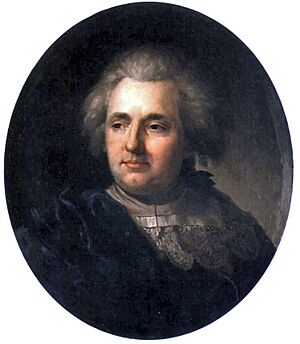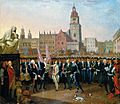Franciszek Smuglewicz facts for kids
Franciszek Smuglewicz (Lithuanian: Pranciškus Smuglevičius) was a famous Polish-Lithuanian artist. He was born on October 6, 1745, and passed away on September 18, 1807. Smuglewicz was a talented draughtsman and painter. Many people consider him the founder of modern Lithuanian art. He also helped introduce a new art style called historicism to Polish painting. He started the Vilnius school of art, and some of his most famous students were Jan Rustem and Jan Krzysztof Damel. His father, Łukasz Smuglewicz, and brother, Antoni, were also painters.
Contents
Early Life and Art Training
Franciszek Smuglewicz was born in Warsaw, the capital of Poland. His father, Łukasz Smuglewicz, was a painter, and his mother was Regina Olesińska. Regina Olesińska was the niece of another painter named Szymon Czechowicz. Franciszek learned to paint in a workshop shared by his father and Czechowicz.
In 1763, when he was about 18, Franciszek traveled to Rome, Italy. There, he began studying fine arts with a teacher named Anton von Maron. He stayed in Rome for 21 years, learning a new art style called Neo-Classicism. This style focused on clear lines, simple forms, and themes from ancient Greece and Rome.
Royal Support and Teaching
In 1765, Franciszek received a special scholarship from the King of Poland, Stanisław August Poniatowski. This helped him join the Saint Lucas Academy, a famous art school in Rome. He also worked with Vincenzo Brenna to help list and organize old artifacts from Nero's Domus Aurea, an ancient Roman palace.
In 1784, Smuglewicz returned to Warsaw. He opened his own school of fine arts there. This school was one of the first steps towards what is now the Academy of Fine Arts in Warsaw.
Artworks and Legacy
Smuglewicz was a classicist artist, but he was also influenced by the Polish baroque style. He became well-known for his historical paintings. This type of painting told stories from the past and was very popular in Poland during the 1800s. Around 1790, he began working on drawings and prints inspired by Adam Naruszewicz's book, History of the Polish Nation. Even though he never finished this series, it made him very popular.
In 1797, he moved to Vilnius, a city that is now the capital of Lithuania. There, he founded and became the first head of the Institute of Sketch and Painting at the Academy of Vilnius.
In 1801, Smuglewicz painted beautiful ceiling murals for Tsar Paul I. These paintings were in the Tsar's new palace, the Mikhailovsky Castle, in Saint Petersburg. This palace was also designed by Vincenzo Brenna, Smuglewicz's old colleague.
Smuglewicz taught many Polish-Lithuanian painters. In his later years, he focused on historical paintings. He brought classical ideas and the spirit of the Enlightenment to Lithuania through his art. He also painted everyday life and the buildings of Vilnius in a very realistic way. His artworks were helpful during the rebuilding of the Royal Palace of Lithuania in Vilnius.
Some of his important surviving paintings include A Meeting of the Four Years' Sejm (1793). Another famous one is Kościuszko's Oath at Kraków's Old Town Market (1797). He also painted Lithuanian Peasants and Freeing Peasants from Serfdom in Merkinė. Many of his works from this time show views of the old city walls and gates of Vilnius, which were later torn down in the 1800s.
Franciszek Smuglewicz was buried in Vilnius at Rasos Cemetery. However, the exact spot where he rests is not known today.
Images for kids
-
Scythians meeting with Darius, painted in 1785.
-
"Tadeusz Kościuszko taking the oath", painted in 1797.
See also
 In Spanish: Franciszek Smuglewicz para niños
In Spanish: Franciszek Smuglewicz para niños





